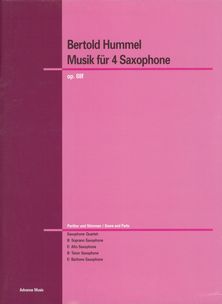MUSIC FOR FOUR SAXOPHONES op. 88f (1990)

I. Allegro vivace
II.
Sostenuto ![]() beginning
beginning
III.
Mixture ![]() beginning
beginning
IV. Finale
First
performance: May 3,1991, Würzburg, Stephanskirche
Normand
DesChênes / Jürgen Faas / Matthias Köhler / Johannes Neuner
Duration: 18 Minutes
Publisher: Schott Music
ADV 7626 / ISMN: 979-0-2063-0743-0 / ISBN: 978-3-89221-691-9
Video: Works by Hummel on youtube
A
tone series, heard at the beginning in unison, is the basic material to be formed
in the first movement. The intervals of a minor third and a fourth
or fifth play a special role, whether in the melody or in the building of chords.
Sharp differences in dynamics and articulation are features of of this first part
of the work with its debt to the classical sonata form.
The Sostenuto
- returning repeatedly to the harmonic and hymn-like gestures of a funeral march
- is subdivided by recitative-like insertions and spinning out of motifs and fading
away in the "abgesang" in an chorale-like episode - a allusion to Bruckner.
The persistent mixture of two overlapping ninths imposes itself
on the vertical aspect of the burlesque third movement. On the horizontal plane,
the intervals of the minor third and the fourth dominate - almost a return of
material from the first movement. The formal structure is A B A, whereby B appears
in the tempo of a Ländler.
The fourth movement begins
with an arioso introduction, followed by an Allegro vivace with rondo character.
Driving rhythms, melodic ideas reminiscent of jazz as well as strong rhythmical
contrasts determine its profile. With a slight air of resignation, the turbulent
finale dies away. The work was composed in 1990 at the suggestion of Normand DesChênes.
Bertold Hummel
The
composer corrected in 1996 the tempo indications in the printed edition by Advance
Music in as follows:
I.
Allegro vivace:
Tempo indication: quarter note =160 instead of quarter
note =144
II.
Sostenuto:
Bar 47: ritardando for the whole bar
Bar 101: rit....
Bar 102: a tempo
Bar 105 to 107: rit ..... Bar 108: Adagio (very slow up to
and including bar 111). Bar 112: poco piu mosso
III.
Mixtur:
Bar 88: a tempo instead of pesante
IV.
Finale:
Bar 44 up to and including 47: accel .... Bar 48: a tempo
Bar 88: rit ...
Bar 103 to 107: accel ...
Bar 109: a tempo
Printing
errors in the score:
II. Sostenuto:
Soprano Sax.:
Bar 60: second note remains f# instead of g
IV.
Finale: Soprano Sax:
Bar 50: e-flat instead of e-double-flat
Bar
90: last note g# instead of a#
Bar 101: Tutti: 2nd note mf instead of f
Bar 134 (last bar): Soprano, Tenor and Baritone Sax: begin f instead of p
Printing
errors in the Soprano Sax. part:
II. Sostenuto:
Bar 60: second note remains f# instead of g
IV.
Finale:
Bar 90: last note g# instead of a#